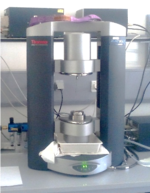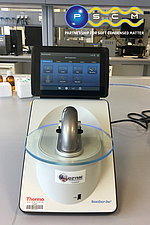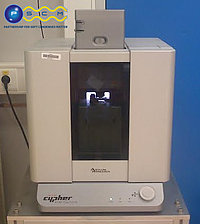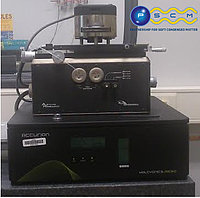PSCM EquipmentALV CGS-3 Static & Dynamic Light Scattering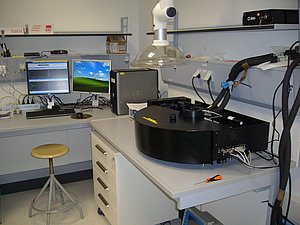 The ALV CGS-3 Compact Goniometer System (ALV GmbH, Langen, FRG) allows for a simultaneous measurement of static and dynamic light scattering. The temperature can be set between 5°C and 50°C. Static light scattering (SLS) measures the form factor in the angular range of 17° and 152° (equivalent to Qmax ≈ 0.00255 Å-1, depending on solvent index of refraction). Combining these techniques yields a supplementary information, the structure sensitive parameter ρ (ρ = RG/RH). It allows for an (overall) shape characterization of particles (e. g. sphere, rod, coil etc.). Rheometer Anton Paar Physica MCR 501The Anton Paar Physica MCR 501 rheometer allows on line (SANS and reflectometry beam line) and off line rheological measurements. Plate plate, cone and plate, and Couette geometries are available allowing a wide range of sample viscosity to be studied. Rheometer Haake Mars II, Thermo Fischer ScientificThis instrument allows the rheological characterization of the flow behaviour and viscoelastic properties of complex fluids and bulk soft matter systems. Six different measuring geometries are available in cone-plate, plate-plate and Couette configuration. Two Peltier controllers allow sample temperature regulation during the measurement in the range from 5 °C up to 85 °C with 0.1°C precision.
Beaglehole Picometer Light Ellipsometer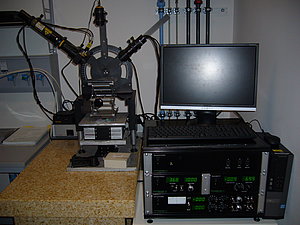 A Beaglehole Picometer Light ellipsometer is optimised for interfacial characterisation at the air/liquid and air/solid interfaces. The interfacial excess can be determined to a precision and sensitivity of < 5% of a surfactant monolayer, and with complementary information or optical modelling the data can be used to quantify the adsorbed amount of material at an interface. Data can be acquired at a rate of up to 200 Hz, hence the instrument provides access to the study of fast adsorption kinetics. The ellipsometer offers two principal benefits to users. First, it can be used as a pre-screening tool to characterise the kinetics and homogeneity of samples before neutron reflectometry (NR) beam time on FIGARO. Also, the interfacial excess of surface-active material may be compared precisely with respect to a changing variable such as solution composition or temperature. Second, the technique has greater sensitivity to species with a similar scattering length density to that of air (e.g. hydrogenated polymers). Therefore the acquisition of an "optical contrast" during NR measurements can reduce the need for as many NR isotopic contrasts thus saving beam time and deuterated chemicals. Kinetic information may be quantified to complement further the neutron reflectometry data, and inhomogeneity in free liquid surfaces can be identified prior to the modelling of NR data. Brewster Angle Microscope Nanofilm EP3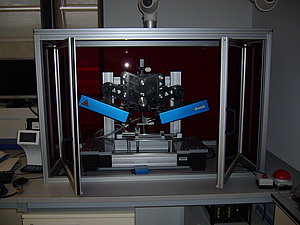 The BAM utilizes the fact that when p-polarized light is guided towards an air-water interface, no reflection occurs at a certain incident angle. This angle, the Brewster angle, is determined by Snell's law and depends on the refractive indices of the materials in the system. The Brewster angle for the air-water interface is 53°, and under this condition the image of a pure water surface appears black. Addition of material to the air-water interface modifies the local refractive index (RI), and hence, a small amount of light is reflected and displayed within the image. The image displayed contains areas of varying brightness determined by the particular molecules and packing densities across the sampling area. Lateral resolution ≥1µm Contact Angle Measuring Instrument DS114, KrussThe drops are generated with a reproducibility of 0.3 microliter and placed on the sample at the touch of a finger. Software-controlled contact angle measurement can start immediately after drop placement - without any further actions being required. With image recording rates of up to 61fps even rapid changes in the contact angle can be recorded. Differential Scanning Calorimeter DSC-131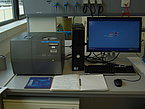 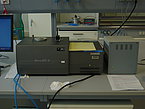 DSC-131
Ellipsometer for SolidsThis is an "home made" ellipsometer by Patrice Ballet at the University Joseph Fourier (Grenoble). The principle of this rotating quarter wave plate ellipsometer can be found at this address : The laser diodes 2 & 3 are required to find the number of periods of the signal. The signal acquisition is done with an A/D conversion card at 100 kHz and with a resolution of 16 bits. The angle of incidence is set to silicon (75 °) but can be changed between 0 and 90 degrees. HPLC Pump for Lipid ExtractionPlasma Cleaner, Harrick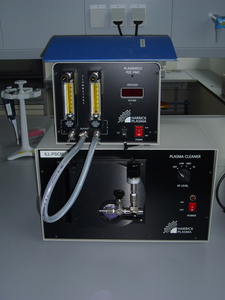 The Plasma Cleaner serves as an excellent tool for surface cleaning, surface preparation and surface modification. Plasma treatment may be applied to a wide variety of materials, including metals, ceramics, composites, plastics, polymers and biomaterials. Tensiometer, Kruss K11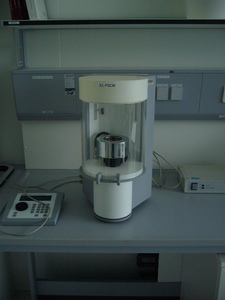 Fully automatic determination of surface and interfacial tension for routine measurements in laboratory and quality control applications. Measuring methods:
Langmuir Trough NIMA 1212D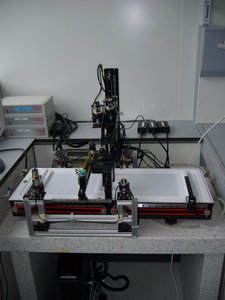 Nima Langmuir trough 1212D used for the preparation of layers on solid substrates from insoluble amphiphilic molecules, typically lipids but also polymers and proteins.
Langmuir Trough NIMA 611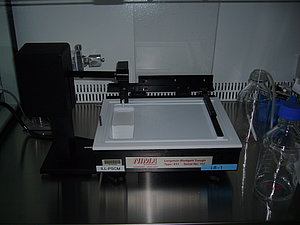 Nima 611 Langmuir trough used for the preparation of layers on solid substrates from insoluble amphiphilic molecules, typically lipids but also polymers and proteins.
Langmuir trough NIMA 721BAMNima Langmuir trough 712BAM used for the preparation of molecular layers on water surfaces from insoluble amphiphilic molecules, typically lipids but also polymers and proteins. Such layers can also be transferred to solid substrates by the built-in accessory allowing Langmuir-Blodgett deposition. Langmuir trough characteristics:
Transfer arm type D1L:
Malvern Zeta-sizer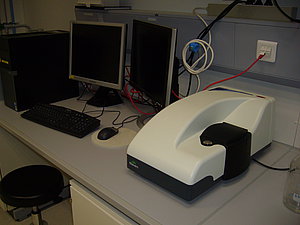 The Zetasizer Nano Z is the perfect system for measuring zeta potential and electrophoretic mobility of colloids and nanoparticles, when the measurement of size or molecular weight is not required. Minimum sample volume: 150 μl SOURCE www.malvern.com Portable Raman Spectrometer, Ocean OpticsA portable Raman spectrometer (Ocean Optics QE65000) is under commissioning. This spectrometer is equipped with a fiber-optics probe head (Ocean Optics RIP-RPB-785-FC) with a 7.5mm focal length which can be used for in-situ applications. The instrument provides a relatively low resolution and no microscopy option, but due to its light weight, compact size and sturdy design can be used both in the soft-matter laboratory as well as on neutron and x-ray instruments. E4 Quartz Crystal Microbalance, Q-Sense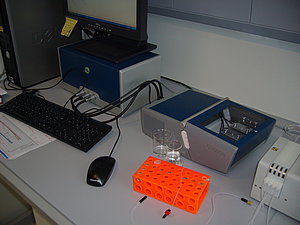 The QCM is a mass sensing device with the ability to measure very small masses changes on a quartz crystal resonator in real time. It is possible to measure mass changes as small as a fraction of monolayer or single layer of atoms. As the second generation of Quartz Crystal Microbalance with Dissipation monitoring (QCM-D) from Q-Sense, the E4 offers the opportunity to study molecular interactions and molecular adsorption to many different types of surfaces. Applications include proteins, lipids, polyelectrolytes, polymers and cells/bacteria interacting with surfaces or with previously bound molecular layers. The instrument determines the mass of very thin surface bound layers and simultaneously gives information about their structural (viscoelastic) properties. It is based on the patented QCM-D technique, an extremely sensitive and fast technique providing multi-frequency and dissipation data that are needed to fully understand the state of molecular layers bound to the sensor surface.
Spin Coater Delta6 SUSS MicroTecDelta6 RC Spin Coater from SUSS MicroTec used to coat solid substrates with polymer or lipid films. Adaptors available for squared and round substrates of 50mm diameter (or 50x50mm² surface) or rectangular (80x50mm² surface). Chuck rotation 0-10,000 rpm depending on size (please, check instructions before use). UV-VIS V-630 Spectrophotometer, Jasco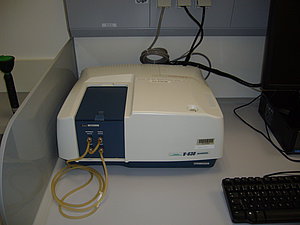 Characteristics:
UV-Visible Nanodrop SpectrophotometerThe Nanodrop is a compact, stand-alone UV-Visible spectrophotometer for micro volume analysis of purified nucleic acids and wide variety of proteins.
AFM-Cypher S Asylum ResearchThanks to its built-in features, the Cypher-S provides significant easiness of use and performance benefits for imaging topography, mechanical, electrical, and magnetic properties in air and liquids.
mally the cantilever. AFM-MFP3D Asylum ResearchThe MFP-3D is ideal for many applications including physics, material science, polymer science, chemistry, nanolithography, bioscience, and quantitative nanoscale measurements. Instrument proprieties:
This AFM can be equipped with a cell for liquid imaging (Closed Fluid Cell CCELL) , which offer the opportunity for example to image cells in their growth medium. Proprieties: Closed Fluid Cell
AFM-Veeco Dimension 3100Beeing logic and built in a simple geometry, it is able to do measurements in samples that are heavy and more than 15mm thick. Brewster Angle Microscope (BAM) EP3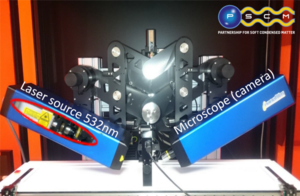 The Accurion EP3-BAM is used to image thin films on solid or liquid substrates. To obtain image contrast, the BAM uses the principle that at a certain incidence (Brewster) angle the p-polarized laser beam is not reflected at all by the substrate-air interface. The Brewster angle depends only on the refractive index (RI) of the substrate and is equal to 53° in the case of a water substrate. At this incidence angle, nano-thick molecular and/or nanoparticle films that are spread at the water surface will modify locally the RI value, thus yielding a non-zero reflection coefficient and providing image contrast.
Microscope Olympus BX61 Thanks to the 3 different light sources and the filters and analysers mounted, the BX61 is a very versatile microscope. It allows the users to perform optical observation using the following imaging modes:
The objectives mounted on the computer-controlled turret are described in the following table: |



